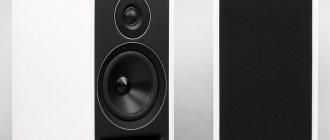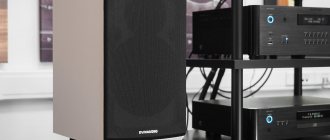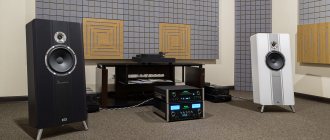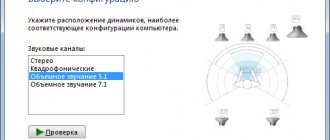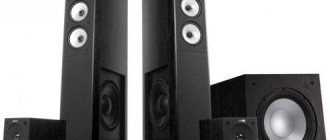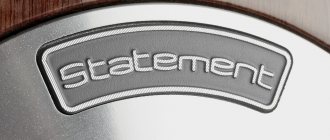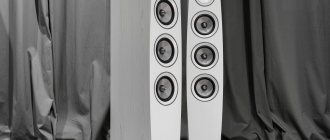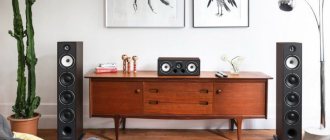Despite the fact that KEF's anniversary took place five years ago, the LS50 speakers developed for this date are still relevant. This year, the company released the anniversary model in new finishes: Frosted Black - a combination of a black lacquered body with a blue emitter, Titanium Gray - a gray body with copper-colored diffusers, and bright Racing Red - a rich red body with a black speaker. Despite the fact that the manufacturer refrained from making any design changes, we decided to once again recall this timeless classic.
Five years have passed since the first release. Passions have cooled, reviews have been written, the trail of marketing campaigns has come to naught. The easier it is to study user reviews in order to better understand what is really worth paying attention to before listening.
It must be said that you can find quite contradictory opinions about these speakers on the Internet. In any case, no one is indifferent, and this already says a lot, at least that the product turned out to be truly interesting. Some people like absolutely everything, some don’t. Some people complain about their shallow bass, excessive monitor sound and low sensitivity. Others, on the contrary, admire their neutral presentation, accurate stage and ability to integrate into almost any audio system. And there are those who hear the difference in the sound of black and white copies. It’s impossible to list everything, we’ll just make a reservation that we were least interested in the reviews gushing with positivity, so similar to those left by the dealers themselves. However, it should be noted that the speakers are selling successfully, so the ongoing discussion only confirms the fact that the manufacturer was not mistaken in betting on their production.
From now on, the anniversary model is available in red, gray and matte black versions
The LS50's marketing program is based on the idea of intertwining the past and the future - the popular ls3/5a monitors produced by a number of companies, including KEF, from 1976 to 1988 for the needs of the BBC and the technological features of the current flagship KEF Blade. The first speakers received the LS index, the second ones received a similar electrodynamic head and individual fragments of technological solutions. And if everything is clear with the latter, then the idea of historical continuity with LS3/5a is, at least, somewhat far-fetched. I was unable to identify anything in common either in the sound or in the design of these acoustic systems, except for their intended purpose - to provide high-quality monitoring of sound recordings mainly at mid frequencies. As a result, we see a modern, extremely high-tech product without any historical aura. Of course, we are not talking about any legendary rebirth of the LS3/5a.
The internal structure of the speakers is replete with numerous bulkheads and screw ties, excluding any overtones
So, the keyword “monitoring” was mentioned, referring us to professional work with sound. Indeed, in its promotional materials, KEF promises to bring studio sound directly to the listener in the form in which the sound engineer heard it. I must admit that this is a very risky and controversial statement. From personal experience communicating with a fairly large pool of sound engineers, I have not yet met anyone who would not complain about the exhausting sound of studio monitors throughout the day, while the LS50 is offered by KEF precisely as the “ultimate minimonitors” that can give the listener a studio experience.
KEF LS50 Meta review
Both the LS50 Meta and LS50 Wireless II feature a 12th generation Uni-Q driver array with innovative Distortion Absorption Technology (MAT). The new Uni-Q driver was developed based on the R-series speaker, but the manufacturer made sure that the new component closely matched the design features of the LS50 Meta system.
First, the introduction of MAT required significant changes to the driver design, so KEF's engineers had to work on improving aspects such as the tweeter cone damper, crossover tuning, and more.
Secondly, the R Series speakers are a 3-way design, while the LS50 Meta is a 2-way speaker, meaning the midrange driver must cover a much wider bandwidth, all the way to the upper end of the low frequencies. While the midrange driver is great for array integration, it does come with some performance overhead.
To optimize the system, KEF's engineering team made a number of changes to the speaker power supply, surround mode, and midrange cone to ensure the speakers operate as smoothly as possible.
Obvious advantages
The recent update of the KEF LS50 color palette has revitalized the branded line. On the active model, the designers continued their experiments, and new combinations were born: a white body with copper drivers and a gray titanium body with red copper-colored emitters. The third color scheme of the LS50W turned out to be the already familiar combination of a black body with blue emitters.
The radiator is extremely unusual and beautiful in its own way. Hidden fins are well cooled by air passing from bottom to top in a natural flow, like in a chimney
Active speakers KEL LS50W are equipped with a remote control. Two facts are noteworthy here. Firstly, of course, the very fact of having a remote control. It is generally accepted that a mobile application is enough to perform any functions, including banal switching on or adjusting the volume. But if you use the LS50W, say, as active acoustics working with a vinyl or CD player, the remote control will not be superfluous. And secondly, the design of the remote control is very unusual: a convenient rounded shape, so recognizable that the bass reflex port can easily be mistaken for the remote control storage area (please do not consider this as a guide to action).
The remote controls are made in colors identical to those of the speakers: the body is the color of the body, and the decorative elements of the buttons are like emitters. At first glance, it’s a trifle, but style is made up of such little things. Personally, I find these things very important.
With any drive design, the same amount of sound waves are generated from the back of the unit as in the front - this radiation is extremely undesirable, so experts are working to find a way to absorb excess resonances. The most important innovation in this speaker is its near-perfect absorption of unwanted noise generated by the tweeter dome. Curious listeners will likely want to know why this is so important.
It is true that the range where only the tweeter is involved without the participation of the bass / midrange dynamics (here we are talking about frequencies above 3 kHz) is not wide enough for you to judge the performance of the tweeter. More telling is to listen to any speaker system without a tweeter connected, then you can feel the difference between a two-way and a three-way system. The sound becomes muffled, and although it is possible to distinguish whether a piano or a violin is currently playing, it is impossible to hear the difference between a Steinway and a Bosendorfer, a Stradivarius and any other violin in the hands of a master.
A true music lover or audiophile definitely wants to hear everything down to the smallest detail. We're not even talking about “realistic” sound effects like hitting keys or the sound of a bow rubbing against strings. In short, listeners want music that is insignificantly different from a live performance, which many miss due to modern realities. It is the tweeter that is responsible for reproducing these details, so the better the tweeter, the greater the pleasure of listening to music.
Settings from the boss
The sound settings menu in the KEF LS50W application is not a boring couple of lines, but a whole world about which you can create legends. Three sections at once for users with different levels of training look completely different from each other.
The first section, called “Default,” is more than laconic. It consists of a message that the sound is set well and there is no need to touch anything. In fact, even in this case there is something to touch, because on the back panel of the acoustics there are two buttons with which you can set the basic parameters that describe the installation conditions: on a stand or on a table, close or far from the wall.
Basic settings are simple and straightforward. If you speak English
The second section “Basic” offers, in addition to these two factors, a more precise description of the situation: for example, indicate the distance to the edge of the tabletop and to the wall in centimeters, indicate the approximate area of the room and the degree of its attenuation, indicate whether a subwoofer is connected. This, in my opinion, is the optimal setting option that allows you to get a good result without special knowledge. Everyone can measure centimeters.
In expert settings, everything is presented in absolute terms. How many dB on the HF should you reduce so that your room does not seem ringing?
In the “Expert” settings, the approach is slightly different; fine adjustments are proposed to be done manually, controlling the output in the high-frequency and low-frequency ranges, adjusting the subwoofer and the frequency of its matching with the acoustics manually. In addition, in expert mode it is possible to disable phase correction. Although I don't see any reason to disable this feature. The presence of a switch only allows you to make sure that KEF engineers are not in vain eating their bread. The difference in detail and focus of the sound stage between the phase correction mode and without it is obvious even to listeners far from the world of hi-fi and audiophile subtleties.
Radiators - a masterpiece of industrial design
Here it is quite reasonable to ask whether all other settings affect the sound just as noticeably, and what will happen if all these adjustments are completely ignored? The installation method settings in any version affect mainly the sound character of the bass and upper mids. If you greatly miss the adjustments in these spectra or do not make them at all, this is where accents appear, and the scene will be drawn less accurately and realistically. In a word, all this digging in the menu makes sense and gives quite audible results.
Metamaterials
Metamaterials are probably best known in the field of optics, where various synthetic materials can be used that have properties that natural materials do not have.
For example, the composite from which the cone is made may consist of materials of different densities and sensitivities, so that the refractive index in different parts of the speaker will be different.
The prefix "meta" has since become widely used due to its ability to describe any synthetic substance with unique characteristics that are not characteristic of natural materials.
The KEF LS50 Meta speaker cones are almost ideal broadband absorbers. The concept of the resonance and distortion absorber was a joint project between KEF and AMG (Acoustic Metamaterials Group). With the participation of Professor Ping Sheng, a world-renowned expert on metamaterials, AMG derived a mathematical equation for the relationship between the absorption spectrum and the physical indicators of surface distortion.
Pun
The KEF LS50 active network speaker received the Wireless prefix, mainly to impress buyers and fit into the current marketing landscape. It has already become a custom that marketers necessarily call devices with Wi-Fi or at least Bluetooth wireless. However, from a purely technical point of view, the LS50W cannot be called completely wireless: in addition to power cables, it requires another LAN cable to connect the master and slave speakers together. And if you connect a TV and a vinyl player, there will be no less wires than in a regular Hi-Fi system. Or is it less? The system will not have an external amplifier and network player, from which another bundle of cables would stretch. And although this question is rather philosophical, it seems to me that reducing the number of wires and components makes the system neater and prettier.
Woofer/midrange design
The Uni-Q driver used to reproduce the low/mid range has also been redesigned to reduce modulation by voice coil movements. However, this time the approach is different from that used for the high-frequency tweeter, in part because the driver has a protruding voice coil (the coil is longer than the magnet bar), as opposed to the tweeter's bottom coil.
Voice coil inductance causes certain problems related to sound transmission. Higher inductance levels create a larger magnetic field as the signal passes through the voice coil. This magnetic field causes distortion and sometimes even deformation of the speaker. Therefore, it is obvious that the lower the inductance of the voice coil, the less magnetic field is formed around the coil, that is, the level of distortion is noticeably reduced.
The voice coil inductance also creates noise when the coil moves in the gap (modulation). The steel acts as a core to increase the inductance of the coil, hence the inductance changes as the position of the coil changes.
This deviation is a significant problem, especially due to non-linear distortions and resonances. As a result, aluminum auxiliary parts are used more frequently on the LS50 Meta than on the original LS50. Aluminum is a conductive metal that creates a common inductive field with the voice coil. Being a virtual short circuit, it reduces the inductance value of the coil, which, in turn, reduces the modulation of the magnetic flux of the motor system - reducing nonlinear distortions.
The low-pass filter is similar to that used in the original LS50, but includes a parallel resonant branch (C3-R3-L4) to compensate for the higher sensitivity in the speaker's upper midrange due to its lower inductance.
Inductor L4 is the only one in the crossover that has a core. It is very important that only resistor R3 controls the tap strength. To this end, the resistance L4 (which may change as the structure heats up during operation) is kept as low as possible.
Irresistibility
The black and blue version looks very impressive. The combination of black gloss, a curved front facade and the aggressive appearance of the Uni-Q emitter, whose suspension is even covered with sharp protruding ribs, reminded me of a xenomorph from the Aliens movie saga. Looks serious and convincing. If you don't miscalculate the design of the stands, the system will look irresistible.
In addition to the remote control, power cables and a patch cord connecting the left and right speakers, the package includes another standard patch cord for Ethernet and a long USB cable for connecting a computer. I would especially like to note that the cables look very high quality and there is no desire to replace them with something more solid.
The choice of inputs is quite rich, you can connect a computer, a TV, a CD player, and even vinyl at the same time
There were no problems connecting the acoustics to the network, provided that DHCP IP addresses are automatically distributed, no manipulations need to be done; connect the cable and the acoustics are already available for operation.
With a USB connection to a computer, everything was not so easy and fast. Windows OS requires a driver, a link to which can be found in the specifications published on the website, instructions or in the video tutorial on connecting acoustics. But at the same time, the site does not have the usual “downloads” section, which is initially confusing.
The placement of touch buttons and indicators does not spoil the design, but does not differ in functionality either.
After installing the driver, the audio stream can be output from any software player installed in Windows. The ASIO protocol is not supported, but Foobar can use equally high-quality WASAPI.
KEF LS50 Meta specifications
- Speaker Type: Bookshelf Speaker
- Housing: with bass reflex
- Speakers: Uni-Q driver array
- Aluminum and magnesium-aluminum alloy diffusers using metamaterial absorber technology (MAT)
- Frequency range (-6 dB): 47 Hz – 45 kHz
- Sensitivity (2.83V, 1m): 85dB SPL
- Active/passive: Passive
- Terminals: Bi-amping/bi-wiring
- Maximum sound pressure level at 1 m: 106 dB
- Harmonic distortion: <0.4% 175 Hz – 20 kHz (90 dB SPL, 1 m)
- Crossover frequency: 2.1 kHz
- Nominal impedance: 8 ohms
- Minimum impedance: 3.5 ohms
- Dimensions (including terminals) : H: 302 mm (11.9 in)
- W: 200 mm (7.8 in)
- D: 278 mm (10.9 in)
Author of the publication
offline 2 hours
A few words about functions
Those who have had the patience to read up to this point may think that this is a very positive image, and therefore it’s time to grumble a little.
So, the acoustics can work on the network, read files from the home server, and right now there is an active process of adding online music services to the player interface with an emphasis on resources with high-quality audio streams.
On the top right column along the front edge there is a touch control panel
However, let's dig a little deeper into the issue of listening to music online. The acoustics use the DLNA/UPnP protocol, which means that the functionality, list of supported formats and display of file information are limited by the protocol. The network player will improve no faster than the protocol used. For most users this will not be a problem; UPnP is a universal and convenient way to connect network audio devices. However, you shouldn’t even dream about DSD, minimizing software losses and conversions during playback and other exquisite intricacies of network audio.
During the pre-premiere display of acoustics in Moscow, the company's business development manager for Europe and Latin America, Julian Jepsen, repeatedly emphasized that the LS50W is not a multi-room acoustic. The mobile application controls several sets of acoustics, but they cannot be combined into a group; the speakers work independently. In the future, perhaps we will still see multiroom from KEF, but for today it is a thing in itself. Those who want to sound several rooms in the same KEF style are still forced to use additional multi-room devices.
Bottom line
When comparing the LS50W to potential competitors, the KEF is clearly closer to the traditional understanding of hi-fi. The acoustics are equipped with a remote control that can be used instead of a gadget; there is no multiroom. Despite the modern look, the functionality is traditional. Don't discount network player and streaming services. Here, I think, the LS50W will not yield to its competitors.
In terms of sound quality, a step forward towards traditional Hi-Fi has been made: the sound has become home-like. These are no longer strict and super-precise monitors that will go to the studio tomorrow. The LS50W is a universal acoustic that can play warmly and beautifully at home, and if necessary, go all out, there is enough power.
The huge hall was voiced confidently by the LS50W. I was sitting in a chair and I didn’t want to turn up the volume, there was also enough bass
The main trump card of the LS50W is the price. Having supplemented the acoustics with a built-in amplifier and network player, the manufacturer raised the price by a third relative to the passive option. In monetary terms - about 500 dollars, money for which neither a Hi-Fi amplifier nor a network player can be found, not to mention two components at once.
Advantages: cost, high-quality sound, flexibility in setup, subwoofer output, remote control, impressive design
Disadvantages: lack of multi-room capabilities, inability to play files from a flash drive, lack of DSD support
